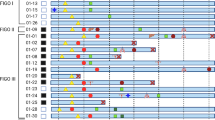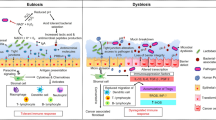Abstract
Cervical cancer is the fourth most common female cancer worldwide. Long non-coding RNAs (lncRNAs), such as SOX21-AS1, play pivotal roles in the progression and metastasis of cancer. We previously described that SOX21-AS1 was hypomethylated in cervical cancer (CC) and aimed to further explore the relationship between methylation of the SOX21-AS1 promoter and CC using clinical cervical samples. Pyrosequencing was performed to detect the methylation status of the SOX21-AS1 promoter in 33 cervical specimens. Additionally, expression levels of related genes in 43 clinical cervical specimens were measured using quantitative real-time PCR (qRT-PCR). The SOX21-AS1 promoter was significantly hypomethylated in CC (P < 0.01). SOX21-AS1 hypomethylation was also significantly associated with an advanced Federation of Gynecology and Obstetrics (FIGO) stage (P < 0.01). The expression levels of SOX21-AS1 and SOX21 were noted to be higher in cancer vs. normal cervix (all P < 0.001). Moreover, the expression of SOX21-AS1 was positively correlated with SOX21 in all samples (r = 0.891, P < 0.001). Methylation statue of the SOX21-AS1 promoter region was negatively correlated with the expression levels of SOX21-AS1 and SOX21 (SOX21-AS1, r = − 0.628; SOX21, r = − 0.648; both P < 0.001). The methylation status of SOX21-AS1 displayed promising diagnostic potential for CC, exhibiting good sensitivity (100.0%) and specificity (69.2%), with an area under the curve of 0.846. In addition, bioinformatic analyses identified a potential link between SOX21-AS1 and the Wnt signaling pathway. Furthermore, methylation status of SOX21-AS1 was negatively correlated with β-catenin/c-myc/cyclin D1 mRNA levels (rs = − 0.529, − 0.462 ,and − 0.383, respectively, P < 0.05). Our findings illuminated that lncRNA SOX21-AS1 showed hypomethylation in cervical cancer and SOX21-AS1 could serve as a novel biomarker for CC diagnosis or a potential therapeutic target.





Similar content being viewed by others
References
Bray F, Ferlay J, Soerjomataram I, Siegel RL, Torre LA, Jemal A. Global cancer statistics 2018: GLOBOCAN estimates of incidence and mortality worldwide for 36 cancers in 185 countries. CA Cancer J Clin. 2018;68(6):394–424.
Ferlay J, Soerjomataram I, Dikshit R, Eser S, Mathers C, Rebelo M, et al. Cancer incidence and mortality worldwide: sources, methods and major patterns in GLOBOCAN 2012. Int J Cancer. 2015;136(5):E359–86.
Bosch FX, Lorincz A, Muñoz N, Meijer CJ, Shah KV. The causal relation between human papillomavirus and cervical cancer. J Clin Pathol. 2002;55(4):244–65.
Walboomers JM, Jacobs MV, Manos MM, Bosch FX, Kummer JA, Shah KV, et al. Human papillomavirus is a necessary cause of invasive cervical cancer worldwide. J Pathol. 1999;189(1):12–9.
Feng Q, Balasubramanian A, Hawes SE, Toure P, Sow PS, Dem A, et al. Detection of hypermethylated genes in women with and without cervical neoplasia. J Natl Cancer Inst. 2005;97(4):273–82.
Bosch FX, Manos MM, Muñoz N, Sherman M, Jansen AM, Peto J, et al. Prevalence of human papillomavirus in cervical cancer: a worldwide perspective. International biological study on cervical cancer (IBSCC) study group. J Natl Cancer Inst. 1995;87(11):796–802.
Kontostathi G, Zoidakis J, Anagnou NP, Pappa KI, Vlahou A, Makridakis M. Proteomics approaches in cervical cancer: focus on the discovery of biomarkers for diagnosis and drug treatment monitoring. Expert Rev Proteomics. 2016;13(8):731–45.
Yang G, Lu X, Yuan L. LncRNA: a link between RNA and cancer. Biochim Biophys Acta. 2014;1839(11):1097–109.
Bhan A, Soleimani M, Mandal SS. Long noncoding RNA and cancer: a new paradigm. Cancer Res. 2017;77(15):3965–81.
Bhan A, Mandal SS. LncRNA HOTAIR: A master regulator of chromatin dynamics and cancer. Biochim Biophys Acta. 2015;1856(1):151–64.
Tsai MC, Spitale RC, Chang HY. Long intergenic noncoding RNAs: new links in cancer progression. Cancer Res. 2011;71(1):3–7.
Wang KC, Yang YW, Liu B, Sanyal A, Corces-Zimmerman R, Chen Y, et al. A long noncoding RNA maintains active chromatin to coordinate homeotic gene expression. Nature. 2011;472(7341):120–4.
He X, Tan X, Wang X, Jin H, Liu L, Ma L, et al. C-Myc-activated long noncoding RNA CCAT1 promotes colon cancer cell proliferation and invasion. Tumour Biol. 2014;35(12):12181–8.
Hadji F, Boulanger MC, Guay SP, Gaudreault N, Amellah S, Mkannez G, et al. Altered DNA methylation of long noncoding RNA H19 in calcific aortic valve disease promotes mineralization by silencing NOTCH1. Circulation. 2016;134(23):1848–62.
Qin R, Chen Z, Ding Y, Hao J, Hu J, Guo F. Long non-coding RNA MEG3 inhibits the proliferation of cervical carcinoma cells through the induction of cell cycle arrest and apoptosis. Neoplasma. 2013;60(5):486–92.
Esteller M. Epigenetics in cancer. N Engl J Med. 2008;358(11):1148–59. https://doi.org/10.1056/NEJMra072067.
Kulis M, Esteller M. DNA methylation and cancer. Adv Genet. 2010;70:27–56.
Leonard SM, Wei W, Collins SI, Pereira M, Diyaf A, Constandinou-Williams C, et al. Oncogenic human papillomavirus imposes an instructive pattern of DNA methylation changes which parallel the natural history of cervical HPV infection in young women. Carcinogenesis. 2012;33(7):1286–93.
Yang CM, Wang TH, Chen HC, Li SC, Lee MC, Liou HH, et al. Aberrant DNA hypermethylation-silenced SOX21-AS1 gene expression and its clinical importance in oral cancer. Clin Epigenetics. 2016;8:129.
Adler P, Kolde R, Kull M, Tkachenko A, Peterson H, Reimand J, et al. Mining for coexpression across hundreds of datasets using novel rank aggregation and visualization methods. Genome Biol. 2009;10(12):R139.
Hoppe-Seyler F, Hoppe-Seyler K. Emerging topics in human tumor virology. Int J Cancer. 2011;129(6):1289–99.
Morgan AE, Davies TJ, Mc Auley MT. The role of DNA methylation in ageing and cancer. Proc Nutr Soc. 2018;77(4):412–22.
Wang R, Li Y, Du P, Zhang X, Li X, Cheng G. Hypomethylation of the lncRNA SOX21-AS1 has clinical prognostic value in cervical cancer. Life Sci. 2019;233:116708.
Kanwal R, Gupta K, Gupta S. Cancer epigenetics: an introduction. Methods Mol Biol. 2015;1238:3–25.
Dawson MA, Kouzarides T. Cancer epigenetics: from mechanism to therapy. Cell. 2012;150(1):12–27.
Zhang X, Zhao X, Li Y, Zhou Y, Zhang Z. Long noncoding RNA SOX21-AS1 promotes cervical cancer progression by competitively sponging miR-7/VDAC1. J Cell Physiol. 2019;234(10):17494–504.
Zhang L, Fang Y, Cheng X, Lian YJ, Xu HL. Silencing of long noncoding RNA SOX21-AS1 relieves neuronal oxidative stress injury in mice with Alzheimer’s disease by upregulating FZD3/5 via the Wnt signaling pathway. Mol Neurobiol. 2019;56(5):3522–37.
Acknowledgments
We would like to thank Linlin Zhang, Yaming Liu, and Haiyang Yu for the prominent technical assistance and valuable suggestions.
Funding
This study was supported by the Science and Technology Department of Henan, China (Grant Number: 22170005) and Science and Technology Department of Henan, China (Grant Number: LHGJ20190392).
Author information
Authors and Affiliations
Corresponding author
Ethics declarations
Conflict of Interest
The authors declare that they have no conflict of interest.
Ethical Approval
All the research has been approved by the ethics committee of The Third Affiliated Hospital of Zhengzhou University.
Additional information
Publisher’s Note
Springer Nature remains neutral with regard to jurisdictional claims in published maps and institutional affiliations.
Peipei Du and Yanfang Zhi are joint first authors.
Rights and permissions
About this article
Cite this article
Du, P., Zhi, Y., Wang, R. et al. Aberrant Methylation of the SOX21-AS1 Promoter Region Promotes Gene Expression and Its Clinical Value in Cervical Cancer. Reprod. Sci. 28, 532–540 (2021). https://doi.org/10.1007/s43032-020-00335-y
Received:
Accepted:
Published:
Issue Date:
DOI: https://doi.org/10.1007/s43032-020-00335-y




